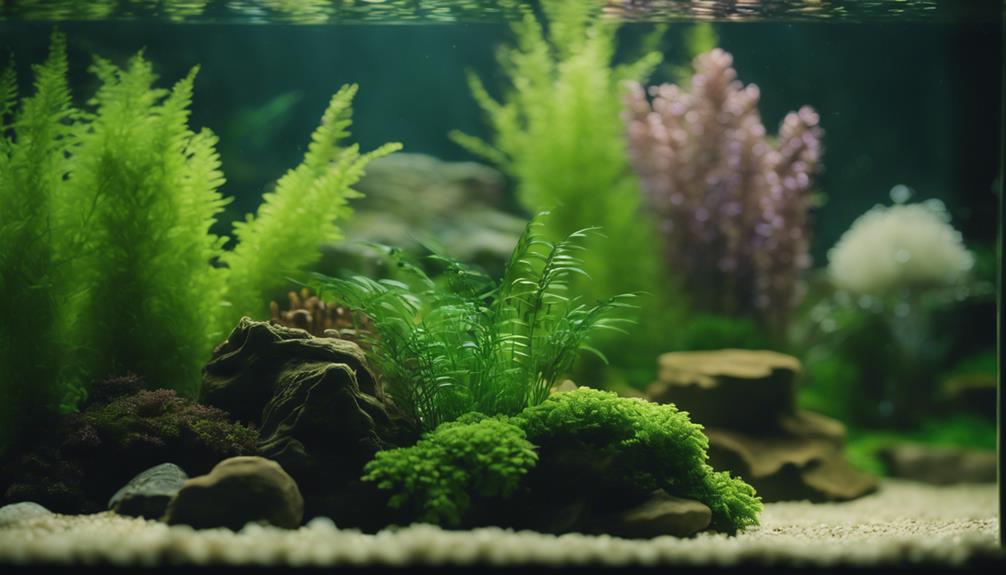When starting your aquatic journey, you'll want to begin with plants that are not only easy to care for but also forgiving of minor mistakes. The Marimo Moss Ball thrives in low-light conditions and has low-maintenance requirements. The Bacopa caroliniana is a stem plant that doesn't require CO2 injection and can tolerate a range of lighting conditions. The Java Fern absorbs nutrients from liquid fertilizers and can thrive in low-light conditions. These hardy plants will help you build confidence in your aquatic plant-keeping skills. As you gain more experience, you'll want to explore more plant options and nuanced care techniques to create a thriving aquatic ecosystem.
Table of Contents
Key Takeaways
- Start with low-maintenance plants like Marimo Moss Ball, Bacopa caroliniana, or Java Fern that thrive in low-light conditions and require minimal care.
- Choose plants that are adaptable to different water conditions, such as Dwarf Sagittaria or Cryptocoryne wendtii, to ensure easy care.
- Research the specific lighting, temperature, and nutrient requirements of each plant to ensure compatibility with your aquarium setup.
- Select plants with a slow to moderate growth rate to avoid overcrowding and allow for easy pruning and maintenance.
- Consider beginner-friendly plants that are hardy and can tolerate minor mistakes, such as Amazon Sword or Anubias barteri.
Top Aquatic Plants for Beginners
When starting your aquatic plant journey, you'll want to choose species that are forgiving and easy to care for, which is why the following aquatic plants are perfect for beginners. These plants will help you build confidence and develop your aquarium-keeping skills.
As a beginner, you'll appreciate the low-maintenance requirements of Marimo Moss Ball, which can thrive in low-light conditions.
Amazon Sword, a classic aquarium plant, is another great option, but it does require regular root tabs to provide necessary nutrients.
If you're looking for a stem plant, Bacopa caroliniana is a good choice, as it doesn't require CO2 injection and can tolerate a range of lighting conditions.
Java Fern and Cryptocoryne wendtii are also excellent options for beginners.
Java Fern absorbs nutrients from liquid fertilizers in the water column and can thrive in low-light conditions.
Cryptocoryne wendtii, on the other hand, is a low-demanding crypt that can thrive in almost any light and substrate conditions.
These plants are all great choices for beginners, and with proper care, they'll help create a beautiful and thriving aquarium.
Easy to Care for Aquarium Plants
The aquatic plants we've discussed so far aren't only perfect for beginners but also incredibly easy to care for, and there are more options to explore in this category.
If you're looking for an easy-to-care-for aquatic plant that requires minimal maintenance, consider the Marimo Moss Ball. It thrives in low-light conditions and is a great choice for those new to aquatic plants.
Bacopa caroliniana is another beginner-friendly option that doesn't require CO2 injection and can tolerate a range of water conditions.
Java Fern is a low-maintenance aquatic plant that absorbs nutrients from liquid fertilizers and can grow in a variety of lighting conditions.
Cryptocoryne wendtii is a low-demanding crypt that can thrive in almost any light and substrate, making it an ideal choice for beginners.
Dwarf Sagittaria is a hardy, grass-like carpeting plant that's easy to care for and can tolerate a range of water conditions.
These aquatic plants are perfect for those who want to add some greenery to their aquarium without the hassle of complicated care routines.
Plant Care and Maintenance Tips
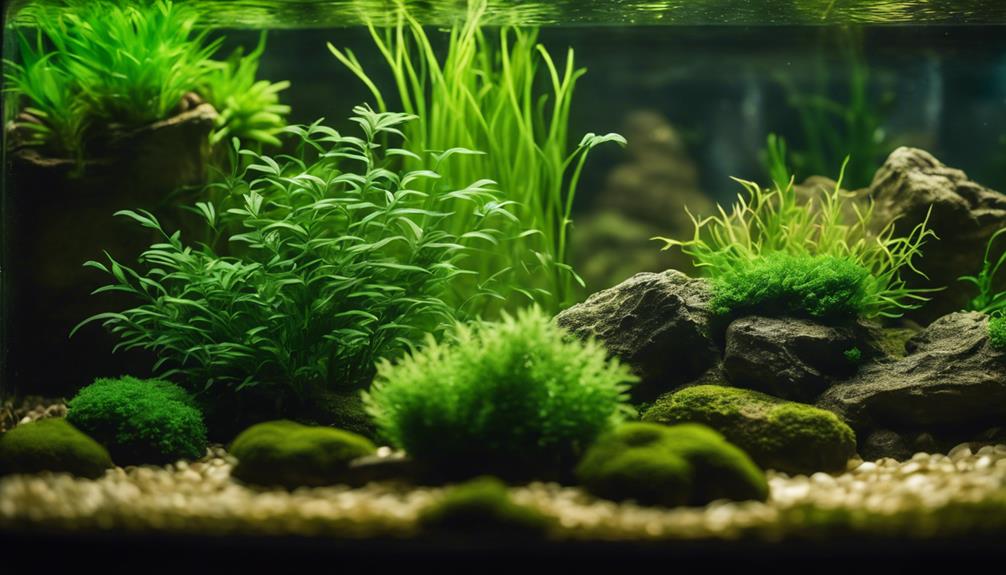
To keep your aquatic plants thriving, a vital aspect is to develop a routine for regular plant care and maintenance, as neglecting these tasks can lead to poor plant health and even death.
You'll need to commit to regular water changes, pruning, and fertilizing to guarantee your plants receive the necessary nutrients.
Feed your plants according to their needs – for example, Amazon Sword and Cryptocoryne wendtii require regular root tabs for healthy growth.
Provide the right lighting conditions – some plants like Bacopa caroliniana can thrive in high light, while others prefer low light.
Monitor your plants' response to fertilizers – if you notice yellowing leaves, it may be a sign that your plant needs more root tabs.
Be gentle when handling your plants – Marimo Moss Ball, for instance, requires rolling in your hands during water changes to maintain its shape and access to light.
Benefits of Live Aquarium Plants
As you consider adding live aquarium plants to your tank, you'll want to know about the benefits they provide.
They improve water quality and reduce algae growth, creating a healthier environment for your fish.
Improved Water Quality
By incorporating live aquarium plants into your tank, you create a natural filter that effectively absorbs CO2 and ammonia produced by fish, ultimately improving water quality and reducing algae growth. This is especially important for maintaining a healthy environment for your aquatic life.
With plants like Amazon swords, you can rest assured that your water quality will improve substantially.
Some key benefits of live aquarium plants on water quality:
They absorb CO2 and ammonia, reducing the need for frequent water changes and creating a more balanced ecosystem.
Plants use nutrients needed for algae growth, reducing or eliminating algal blooms and creating a more balanced ecosystem.
Live plants provide a natural way to purify water, removing waste products and toxins that can harm fish and other aquatic life.
Reduced Algae Growth
Your aquarium's algae growth can be substantially reduced with the introduction of live plants, which absorb excess nutrients from the water, making it difficult for algae to thrive.
By adding plants like Java Moss, you'll create an environment where algae struggles to survive.
This is because live plants absorb the nutrients that algae need to grow, effectively starving them out.
Additionally, plants like Amazon Swords and Pond Weed are also effective at absorbing nutrients, making them great options for beginners.
Choosing the Right Aquarium Plant
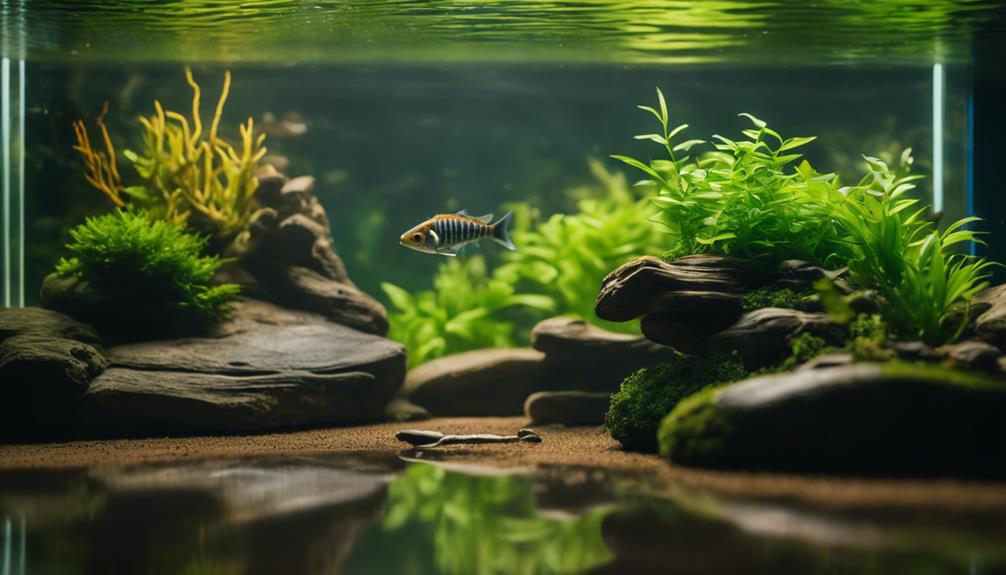
When setting up your aquarium, you'll want to choose plants that not only thrive in water but also complement your tank's unique conditions and inhabitants. This means researching the specific needs of each aquatic plant to guarantee they'll flourish in your tank.
Some key factors to ponder when selecting the right plants for your aquarium include:
- Researching the specific lighting, temperature, and nutrient requirements of each plant
- Selecting plants suitable for your aquarium's water type (fresh or brackish)
- Evaluating the plant's growth rate and maximum size to avoid overcrowding
- Choosing low-maintenance plants like Crypt wendtii, Bacopa caroliniana, or Java Fern that are forgiving of minor mistakes
Lighting and Fertilization Essentials
Now that you've chosen the right aquarium plant, it's time to focus on providing the essential elements for its growth.
You'll need to decide on a suitable lighting option that meets your plant's specific needs, and consider the type of fertilizer that will provide the necessary nutrients.
Lighting Options Explained
To create an ideal environment for your aquatic plants, you'll need to select a suitable lighting option that provides the right spectrum and intensity for photosynthesis. As a beginner, it's crucial to understand the different lighting options available and choose the one that suits your aquarium's specific needs.
Fluorescent lighting (T-5 and T-8) is a popular and inexpensive option, emitting little heat and suitable for most aquarium setups.
LED aquarium lighting is a long-lasting and flexible option, lasting over 50,000 hours and emitting no heat, making it perfect for planted aquariums.
Metal Halide lighting is a more expensive option, typically used for deep marine aquaria, and isn't necessary for most freshwater planted aquariums.
Incandescent light bulbs should be avoided, as they emit the wrong type of light and can cause more harm than good to aquatic plants.
Remember to use a timer to maintain a consistent 8-10 hour photoperiod, allowing your plants to undergo photosynthesis and rest.
Fertilizer Types Compared
You've successfully set up your aquarium's lighting, and now it's time to ponder the essential nutrients your aquatic plants need to thrive, which is where fertilizers come into play. Fertilizers provide the necessary nutrients for healthy plant growth, and choosing the right type can be overwhelming. Let's compare some common fertilizer types to help you make an informed decision.
| Fertilizer Type | Benefits | Drawbacks |
|---|---|---|
| Liquid Fertilizers | Easy to dose, promotes healthy plant growth | Can be expensive, may cause algae blooms |
| Root Tabs | Targets root system, promoting strong roots | May not provide enough nutrients for foliage |
| Iron Supplements | Essential for plant health, prevents iron deficiency | Can be toxic in excess, requires careful dosing |
| Complete Fertilizers | Provides all necessary nutrients, convenient | May not be tailored to specific plant needs |
| Custom Fertilizers | Allows for tailored nutrient delivery, cost-effective | Requires research and experimentation |
When selecting a fertilizer, consider your aquatic plants' specific needs and your personal preferences. Iron supplements, for example, are essential for preventing iron deficiency, while root tabs target the root system for strong, healthy roots. By understanding the benefits and drawbacks of each type, you can provide your aquatic plants with the necessary nutrients to thrive.
Optimal Photoperiod Timing
With your fertilizer selection in place, this pivotal step involves synchronizing your photoperiod timing to provide your aquatic plants with the ideal amount of light, as this essential factor directly impacts their growth and development. You want to guarantee you're giving your plants the right amount of light to thrive.
A photoperiod of 8-10 hours is recommended for most aquatic plants, but some species require more or less light depending on their specific needs.
Fluorescent lighting (T-5 and T-8) is a popular option, but LED lighting is a more energy-efficient and long-lasting alternative.
Use a timer to maintain a consistent photoperiod and guarantee your plants receive the right amount of light.
Adjust your lighting based on the specific needs of your plants, as some species require more intense lighting and others prefer lower light levels for ideal growth.
Plant-Specific Care and Characteristics
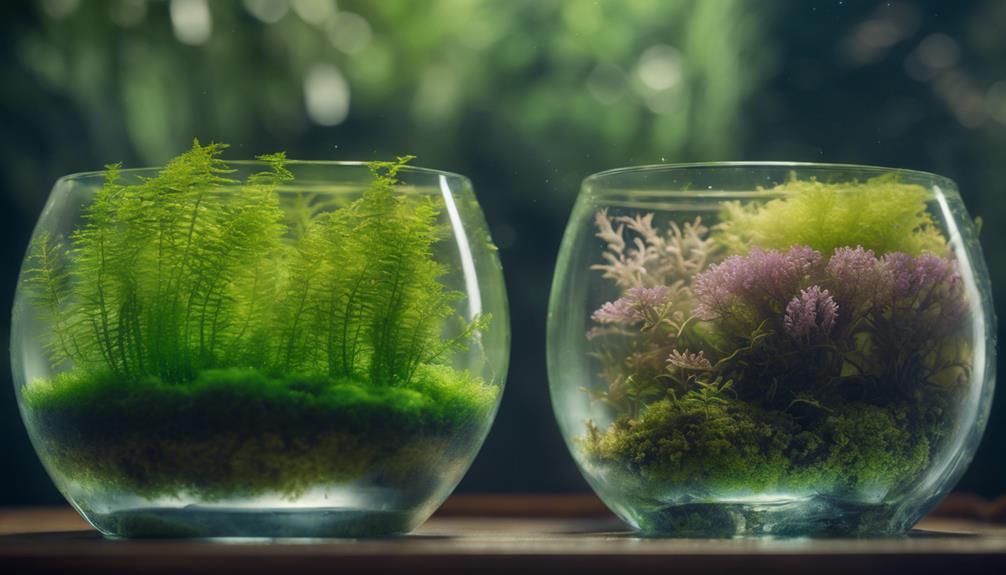
When choosing aquatic plants for your aquarium, understanding their unique care requirements and characteristics is essential for their survival and thriving.
As you select the perfect plants to coexist with your aquarium fish, consider their specific needs.
For instance, Amazon Swords, originating from South America, require a nutritious substrate or root tab type plant fertilizer to thrive. They can grow up to 30-50 cm tall, making them a great addition to your aquarium.
On the other hand, Java Moss spreads rapidly and needs regular feeding with a liquid plant feed.
Pond Weed, also from South America, can tolerate temperatures between 15-28°C and pH 5-8, making it a hardy choice.
Anubias barteri, native to West Africa, is adaptable to various water conditions and can tolerate low light, growing up to 23 cm tall.
Finally, Java Fern, from Asia, can thrive in temperatures between 18°C to 30°C and grows up to 25 cm tall.
Common Mistakes to Avoid
As you set up your planted aquarium, you'll want to avoid some common pitfalls that can hinder your success.
You're likely to encounter issues if you don't understand the specific needs of your plants or choose the wrong ones for your tank.
Overlooking Plant Needs
You're likely to sabotage your aquatic plant's survival if you neglect to research and understand its specific light, temperature, and nutrient requirements. This oversight can lead to poor growth, decay, or even death.
To avoid this, make sure you explore into the needs of your chosen plant before introducing it to your aquarium.
Some key factors to ponder include:
- Lighting: Verify your plant receives the right intensity and spectrum of light to promote healthy growth and prevent algae blooms.
- Temperature: Check the ideal temperature range for your plant and maintain it to encourage new growth and prevent stress.
- Nutrients: Provide the necessary nutrients through fertilizers or a balanced substrate to support your plant's development.
- Water parameters: Monitor and adjust water parameters like pH, hardness, and oxygen levels to create a favorable environment for your aquatic plant.
Incorrect Plant Choice
Selecting an aquatic plant that's mismatched with your aquarium's conditions or your level of expertise is a common pitfall that can lead to disappointment and frustration. As a beginner, vital to choose plants that thrive in your tank's environment and fit your care level. For instance, sword plants are great for beginners, but they require moderate to high lighting. If your tank has low lighting, you may end up with a dying plant.
| Plant Type | Ideal Conditions |
|---|---|
| Sword Plants | Moderate to High Lighting |
| Java Moss | Low Lighting, High Humidity |
| Anacharis | High Lighting, Fast Water Flow |
In planted tanks, pivotal to research the specific needs of each plant species. Don't assume that all aquatic plants are created equal or can thrive in any environment. By choosing plants that fit your tank's conditions, you'll set yourself up for success and create a thriving underwater world. Remember, a well-matched plant choice is key to a beautiful and healthy aquarium.
Fish and Snail Compatibility
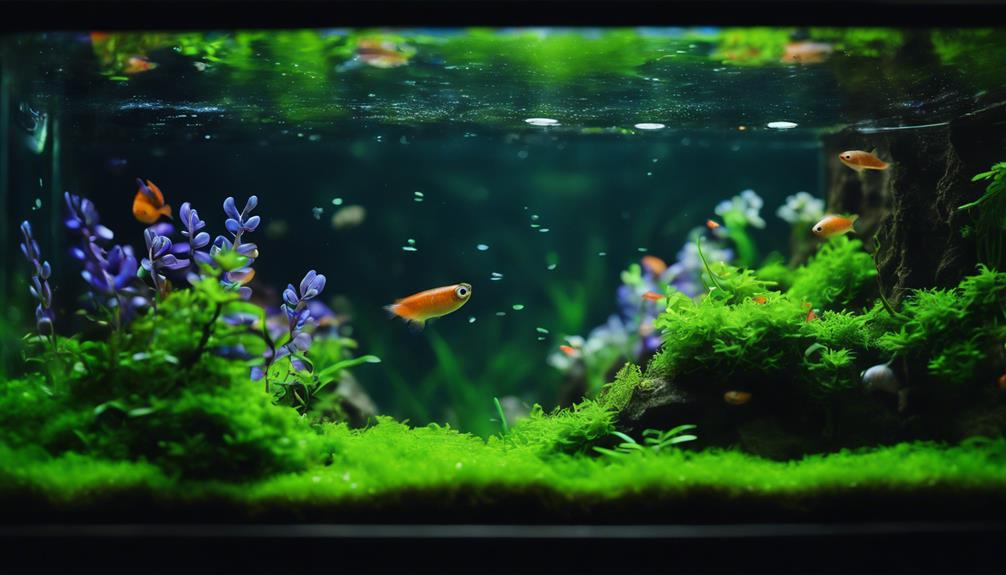
When stocking your planted aquarium, it's crucial to choose fish and snail species that coexist peacefully with your aquatic plants. You want to create a harmonious environment where your plants can thrive, and your fish and snails can enjoy their new home.
Avoid fish species that are known to eat or uproot aquatic plants, such as goldfish and cichlids.
Snails like Nerite snails and Amano shrimps can be great additions to a planted tank, as they help with algae control and are generally plant-friendly.
Research the specific feeding habits and plant tolerance of fish species to guarantee compatibility with your aquatic plants.
Some species of fish, like small schooling fish and peaceful bottom-dwellers, are well-suited for planted aquariums and can coexist with aquatic plants.
Creating a Balanced Ecosystem
To create a thriving aquatic environment, introduce aquatic plants that absorb excess nutrients, provide hiding places for fish, and create natural boundaries for territorial species, thereby achieving a balanced ecosystem.
By doing so, you'll improve water quality, reduce algal growth, and create a haven for small fry.
Selecting plant species tolerant of varying water conditions and lower light levels, such as Amazon Swords, Java Moss, and Pond Weed, will help you achieve this balance.
Aquatic plants require a combination of light, CO2, micro, and macro nutrients to survive. If necessary, fertilizers can provide the necessary nutrients not provided by fish waste and tap water.
Regularly testing water parameters and making adjustments as needed will help maintain a balanced ecosystem, ensuring the health and well-being of both fish and aquatic plants.
Plant Selection for Community Aquariums
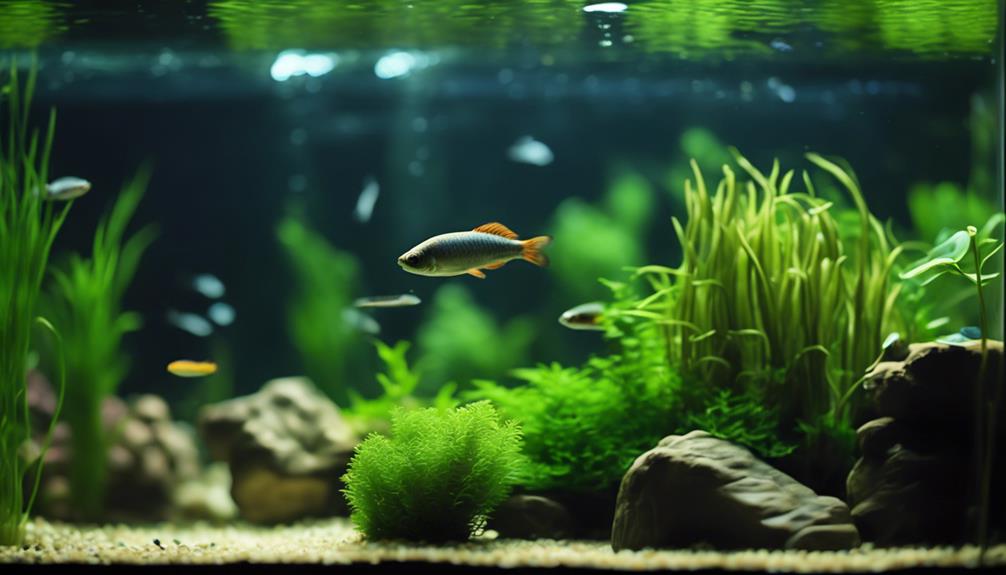
You'll want to populate your community aquarium with plants that not only coexist with your fish but also enhance the overall aesthetic and health of the environment.
When it comes to plant selection for community aquariums, it's vital to choose species that are compatible with the tank's water parameters, lighting, and inhabitants.
Java Fern, Bacopa caroliniana, and Dwarf Sagittaria are low-maintenance and easy to care for, making them perfect for community aquariums.
Amazon Sword, Cryptocoryne wendtii, and Vallisneria are relatively hardy and can tolerate some neglect, making them suitable for busy beginners.
A mix of plant species with varying growth rates, textures, and colors can create a visually appealing and thriving community aquarium.
Avoid plant species that are prone to aggressive growth or require excessive maintenance, such as certain types of Hygrophila or stem plants that need frequent pruning.
Frequently Asked Questions
What Is the Best Aquarium Plant for Beginners?
When choosing an aquarium plant, you want something that's easy to care for and can thrive in low lighting. For a hassle-free experience, look for plants that require minimal maintenance, like the Java Fern or Marimo Moss Ball, perfect for beginners like you.
What Are the First Aquatic Plants?
You're getting in on the ground floor with your first aquatic plants, and "breaking a leg" with early bloomers like water wisteria is a great start; these easy-to-grow species will help you build confidence in your aquarium gardening skills.
What Aquatic Plants Are Best for Dry Start?
When setting up a dry start, you'll appreciate the benefits of plantless decoration, as it allows you to create a visually appealing aquascape before adding water and plants like Java Moss, Dwarf Sagittaria, or Cryptocoryne lutea.
How Do You Arrange Aquatic Plants?
When crafting your aquascape design, you'll want to finesse plant placement by strategically situating larger plants in the background, then adding smaller ones to create visual harmony, and don't forget to leave some swimming space for your fish friends!
Conclusion
As you plunge into the world of aquatic plants, remember that you're not just adding decorations to your tank – you're weaving a tapestry of life.
With the right plants, your aquarium will thrive, and you'll reap the rewards of a balanced ecosystem.
By choosing easy-to-care-for species and avoiding common mistakes, you'll be well on your way to creating a stunning underwater landscape that will leave you and your fish swimming in harmony.

